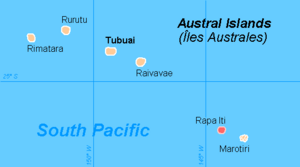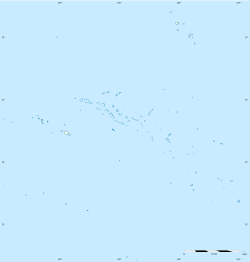Rapa Iti facts for kids

NASA picture of Rapa
|
|
|
Rapa Iti is located in French Polynesia
|
|
| Geography | |
|---|---|
| Location | Pacific Ocean |
| Coordinates | 27°36′S 144°20′W / 27.600°S 144.333°W |
| Archipelago | Australes |
| Area | 40.5 km2 (15.6 sq mi) |
| Highest elevation | 650 m (2,130 ft) |
| Highest point | Mount Perahu |
| Administration | |
|
France
|
|
| Overseas collectivity | French Polynesia |
| Commune | Rapa Iti |
| Demographics | |
| Population | 507 (2017) |
|
Rapa
|
||
|---|---|---|
|
||
 |
||
| Country | France | |
| Overseas collectivity | French Polynesia | |
| Subdivision | Austral Islands | |
| Area
1
|
40.54 km2 (15.65 sq mi) | |
| Population
(2017)
|
507 | |
| • Density | 12.506/km2 (32.39/sq mi) | |
| Time zone | UTC−10:00 | |
| INSEE/Postal code |
98741 /98751
|
|
| Elevation | 0–650 m (0–2,133 ft) | |
| 1 French Land Register data, which excludes lakes, ponds, glaciers > 1 km2 (0.386 sq mi or 247 acres) and river estuaries. | ||
Rapa, also known as Rapa Iti (meaning "Little Rapa"), is a beautiful island in French Polynesia. It is the largest and only island where people live in the Bass Islands. People sometimes call it "Little Rapa" to tell it apart from Rapa Nui, which means "Big Rapa." An older name for the island is Oparo.
The total land area of Rapa Iti, including small islands nearby, is about 40.5 square kilometers (15.6 square miles). In 2017, about 507 people lived there. The highest point on the island is Mount Perahu, which is 650 meters (2,133 feet) tall. The main town on Rapa Iti is Ahuréi. The people of Rapa Iti speak their own special Polynesian language called the Rapa language.
Contents
Exploring Rapa Iti's Geography
Rapa Iti is located in the Pacific Ocean at 27°35′00″S 144°20′00″W. The island looks a bit like the Greek letter sigma (ς). It has a big, safe bay in the middle. This bay is surrounded by tall mountains. The whole island seems to be the top of a sinking volcano, with the bay being the volcano's caldera (a large crater). The main island itself covers 38.5 square kilometers (14.9 square miles). There is also a small island nearby called Little Rapa Tauturau.
Towns and People of Rapa Iti
The main town, Ahuréi (or Ha'uréi), is on the southern side of the central bay. This bay is known as the Baie d'Ahuréi. A smaller village called 'Area is on the northern side of the bay. The people who live here are Polynesian. In the past, there was a lot of fighting on the island. You can still see 28 old forts built on the ridgetops from those times. Today, Rapa Iti is famous for the Tahitian Choir. About a third of the island's population sings traditional songs in this choir.
Rapa Iti and the Bass Islands are sometimes grouped with the Austral Islands. However, they have a different history when it comes to their geology (how the land formed), language, and culture.
A Look at Rapa Iti's History
People first settled on Rapa Iti around the 12th century. These were Polynesians. Over many centuries, their Polynesian language slowly changed into the Rapa language that is spoken today.
Ancient Forts and Early Life
It is believed that the island's natural resources started to run out. This led to conflicts and wars among the people. Because of this, the inhabitants built up to 14 fortified settlements. These forts were called pa or pare and were built on peaks and clifftops for protection. The oldest of these forts is thought to be Morongo Uta, which was built between 1450 and 1550 AD.
European Contact and Changes
The first European to visit Rapa Iti was George Vancouver. He arrived on December 22, 1791, and named the island Oparo. When Europeans came, they brought new things, but also diseases. Between 1824 and 1830, more than three-quarters of the native people died because of these diseases. People were also taken from the island by slave traders from Peru. When some of these people returned, they brought smallpox with them, which caused a terrible sickness to spread. In 1826, there were almost 2,000 people living on Rapa Iti. Forty years later, there were fewer than 120.
Becoming Part of France
Rapa Iti was an independent island kingdom for a while. In 1867, it became a French protectorate, meaning France offered it protection. The British also set up a coaling station on the island. This made France decide to officially take over the island on March 6, 1881. After this, the native monarchy (the system of kings and queens) was ended. The last queen, who was the daughter of Parima, was removed from power on June 18, 1887.
Connecting Rapa Iti to Easter Island
A famous explorer named Thor Heyerdahl did some digging at Morongo Uta. He was looking for connections between Rapa Iti and Rapa Nui (Easter Island).
Understanding Rapa Iti's Climate
Rapa Iti has a tropical rainforest climate. This means it is warm and rainy all year round. It is located south of the Tropic of Capricorn. However, because it is far out in the middle of the ocean, the weather stays mild in all seasons.
Seasonal Weather Patterns
Summers on Rapa Iti are hot and humid. Strong storms called cyclones are not very common here. This is because the island is near the Horse Latitudes, which are areas of calm winds. Even though it's windy, the summer weather is not too extreme. It is very rare for the weather to be extremely hot. The highest temperature ever recorded was 31.6 °C (88.9 °F) in March.
Winters are mild and can be very stormy. This is due to Rapa Iti's isolated location in the ocean. It rains a lot throughout the year, and sunny days are not very common. Because of the cool winters and strong winds, tropical fruits like coconuts do not grow well here. The temperature has dropped to 8.5 °C (47.3 °F) in September. Also, the seasons change slowly here, so March is the second warmest month, and September is the coldest.
| Climate data for Rapa, French Polynesia, 1981-2010 normals, extremes 1951-present | |||||||||||||
|---|---|---|---|---|---|---|---|---|---|---|---|---|---|
| Month | Jan | Feb | Mar | Apr | May | Jun | Jul | Aug | Sep | Oct | Nov | Dec | Year |
| Record high °C (°F) | 31.0 (87.8) |
30.9 (87.6) |
31.6 (88.9) |
30.3 (86.5) |
28.1 (82.6) |
26.3 (79.3) |
24.7 (76.5) |
25.0 (77.0) |
26.4 (79.5) |
26.4 (79.5) |
28.9 (84.0) |
30.1 (86.2) |
31.6 (88.9) |
| Mean daily maximum °C (°F) | 25.7 (78.3) |
26.4 (79.5) |
26.1 (79.0) |
24.5 (76.1) |
22.9 (73.2) |
21.4 (70.5) |
20.7 (69.3) |
20.4 (68.7) |
20.4 (68.7) |
21.4 (70.5) |
22.7 (72.9) |
24.0 (75.2) |
23.0 (73.4) |
| Daily mean °C (°F) | 23.7 (74.7) |
24.4 (75.9) |
23.9 (75.0) |
22.4 (72.3) |
20.8 (69.4) |
19.1 (66.4) |
18.4 (65.1) |
18.1 (64.6) |
18.1 (64.6) |
19.2 (66.6) |
20.6 (69.1) |
21.9 (71.4) |
20.9 (69.6) |
| Mean daily minimum °C (°F) | 21.7 (71.1) |
22.3 (72.1) |
21.7 (71.1) |
20.2 (68.4) |
18.6 (65.5) |
16.8 (62.2) |
16.2 (61.2) |
15.8 (60.4) |
15.8 (60.4) |
16.9 (62.4) |
18.5 (65.3) |
19.9 (67.8) |
18.7 (65.7) |
| Record low °C (°F) | 12.2 (54.0) |
15.6 (60.1) |
15.2 (59.4) |
13.5 (56.3) |
10.1 (50.2) |
10.2 (50.4) |
9.8 (49.6) |
8.9 (48.0) |
8.5 (47.3) |
10.5 (50.9) |
12.0 (53.6) |
13.2 (55.8) |
8.5 (47.3) |
| Average precipitation mm (inches) | 229.4 (9.03) |
186.9 (7.36) |
275.8 (10.86) |
251.4 (9.90) |
185.0 (7.28) |
208.7 (8.22) |
258.4 (10.17) |
237.8 (9.36) |
165.1 (6.50) |
184.1 (7.25) |
170.6 (6.72) |
221.4 (8.72) |
2,574.6 (101.36) |
| Average precipitation days (≥ 1 mm) | 13.2 | 12.5 | 15.3 | 14.9 | 14.5 | 15.7 | 15.4 | 15.5 | 12.7 | 12.2 | 11.8 | 12.7 | 166.4 |
| Mean monthly sunshine hours | 128.9 | 130.3 | 129.1 | 107.7 | 96.6 | 78.9 | 95.0 | — | 104.1 | 119.1 | 129.3 | 119.6 | — |
| Source: Meteo France | |||||||||||||
Protecting Rapa Iti's Environment
The Manatau French Polynesian Reserve is a special protected area in southern Rapa. It helps to keep the animals safe and preserve the old ridgetop forts. This reserve is located near South Ahuréi.
Unique Birds of Rapa Iti
Rapa Iti is home to some very special birds that are found nowhere else in the world.
- The Rapa fruit dove is a unique bird that lives only here. It is in great danger of disappearing. This is because its home is being lost, and wild cats hunt these doves. People also hunt them. In 2017, there were only about 160 of these birds left.
- The Rapa shearwater is another bird found only on the small islands around Rapa Iti. It is also critically endangered.
- Other birds like Murphy's petrel nest here in small numbers.
- The bristle-thighed curlew visits Rapa Iti when it migrates, but it does not breed here.
Because Rapa Iti is so important for these bird species, BirdLife International has named it an Important Bird Area.
How Rapa Iti is Governed
The local government area, called the commune of Rapa, includes the main island of Rapa Iti. It also includes four uninhabited rocks known as Marotiri.
See also
 In Spanish: Rapa para niños
In Spanish: Rapa para niños



